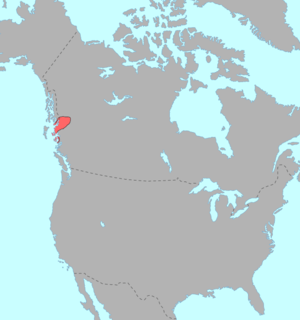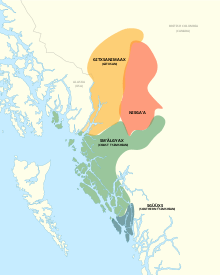Tsimshianic languages
The Tsimshianic languages are a family of languages spoken in northwestern British Columbia and in Southeast Alaska on Annette Island and Ketchikan. All Tsimshianic languages are endangered, some with only around 400 speakers. Only around 2,170 people of the ethnic Tsimshian /ˈsɪmʃiən/ population in Canada still speak a Tsimshian language;[2] about 50 of the 1,300 Tsimshian people living in Alaska still speak Coast Tsimshian.[3][4] Tsimshianic languages are considered by most linguists to be an independent language family, with four main languages: Coast Tsimshian, Southern Tsimshian, Nisg̱a’a, and Gitksan.[5]
| Tsimshianic | |
|---|---|
| Tsmksian | |
| Ethnicity | Tsimshian |
| Geographic distribution | British Columbia, Alaska |
| Linguistic classification | Penutian ?
|
| Subdivisions |
|
| Glottolog | tsim1258[1] |
 Pre-contact distribution of Tsimshianic languages | |
The Tsimshianic languages were included by Edward Sapir in his Penutian hypothesis, which is currently not widely accepted, at least in its full form. The Penutian connections of Tsimshianic have been reevaluated by Marie-Lucie Tarpent, who finds the idea probable,[6] though others hold that the Tsimshianic family is not closely related to any North American language.[7][8]
Family division

Tsimshianic consists of 4 lects:
- Tsimshian (also known as Maritime Tsimshianic, Lower Tsimshian, Northern Tsimshian)
- Coast Tsimshian (also known as Tsimshian proper, Sm’algyax̣, Sm’algax)
- Southern Tsimshian (also known as Sgüüx̣s, Ski:xs, Old Klemtu) †
- Nass–Gitksan (also known as Interior Tsimshianic, Inland Tsimshianic)
Coast Tsimshian is spoken along the lower Skeena River in Northwestern British Columbia, on some neighbouring islands, and to the north at New Metlakatla, Alaska. Southern Tsimshian was spoken on an island quite far south of the Skeena River in the village of Klemtu, however it became extinct in 2013. Nisga’a is spoken along the Nass River. Gitksan is spoken along the Upper Skeena River around Hazelton and other areas.
Nisga’a and Gitksan are very closely related and are usually considered dialects of the same language by linguists. However, speakers from both groups consider themselves ethnically separate from each other and from the Tsimshian and thus consider Nisga’a and Gitksan to be separate languages. Coast and Southern Tsimshian are also often regarded as dialects of the same language.
As of 2013, Tsimshian courses are available at the University of Alaska Southeast.[9]
Phonology
Consonantal inventory of Proto-Tsimshian:[10]
| Labial | Dental | Palatal | Velar | Labio- velar |
Uvular | Labio- uvular |
Glottal | |||
|---|---|---|---|---|---|---|---|---|---|---|
| Non-continuous obstruent |
simple | *p | *t | *ts | *k | *kʷ | *q | *qʷ | *ʔ, *ʔʷ | |
| glottalized | *pʼ | *tʼ | *tsʼ | *kʼ | *kʷʼ | *qʼ | *qʷʼ | |||
| Fricative | *s, *ɬ | *x | *χ | *χʷ | *h, *hʷ | |||||
| Approximant | simple | *l | *j | *w | ||||||
| glottalized | *lˀ | *jˀ | *wˀ | |||||||
| Nasal | simple | *m | *n | |||||||
| glottalized | *mˀ | *nˀ | ||||||||
See also
Footnotes
- Hammarström, Harald; Forkel, Robert; Haspelmath, Martin, eds. (2017). "Tsimshian". Glottolog 3.0. Jena, Germany: Max Planck Institute for the Science of Human History.
- Statistics Canada 2006
- Alaska Native Language Center. (2001-12-07). "Tsimshian." Archived 2007-05-01 at the Wayback Machine University of Alaska Fairbanks. Retrieved on 2007-04-11.
- Gordon, Raymond G., Jr. (ed.). (2005). "Tsimshian." Ethnologue: Languages of the World, 15th ed. (online version). Dallas, TX: SIL International Retrieved on 2007-04-11.
- Alaska Native Heritage Center. (2000). "Eyak, Haida, Tlingit & Tsimshian." Retrieved on 2007-04-11.
- Tarpent, Marie-Lucie (1997). "Tsimshianic and Penutian: Problems, Methods, Results, and Implications". International Journal of American Linguistics. 63 (1): 65–112. doi:10.1086/466314. JSTOR 1265865.
- Bicevskis, Katie; Davis, Henry; Matthewson, Lisa (2017). "Quantification in Gitksan". In Paperno, Denis; Keenan, Edward L. (eds.). Handbook of Quantifiers in Natural Language. Studies in Linguistics and Philosophy. II. Springer. p. 282. doi:10.1007/978-3-319-44330-0_6. ISBN 978-3-319-44328-7.
Though Tsimshianic is unmistakably part of the central northwest coastal Sprachbund (Beck 2002), no convincing evidence has been forthcoming for a genetic relationship between it and any other language family, in spite of persistent attempts to lump the family into the hypothetical Penutian stock, whose other members are found far to the south in Oregon and California (see for example Sapir 1921 and Tarpent 1997).
- Brown, Jason (2010). Gitksan Phonotactics. Munich: Lincom Europa. p. 5. ISBN 978-3-89586-589-3.
While the Tsimshianic language family is considered by some to be an isolate, others have considered it to be a member of a much larger stock. In particular, Sapir (1921) classified Tsimshianic as a part of the Penutian stock. More recently, DeLancey et al. (1988) and Tarpent (1996, 1997) have re-argued this point, suggesting that Tsimshianic is indeed a Penutian language. These authors point to morphological, phonemic, and lexical correspondences to make this claim. However, the major problems that have been expressed in the literature about the Penutian stock, as well as the problems with Tsimshianic as a part of that stock (see the discussion in Rigsby 1986, as well as Campbell 1997 for a general overview) cast doubt on this relationship. I take the conservative position that the Tsimshianic family is an isolate, and not related to the Penutian stock, or any other hypothesized stocks, though nothing in this work hinges on that position.
- Lisa Phu (Director) (2013-10-22). "UAS and Yukon College partnership advances Native language efforts". KTOO, Juneau, Alaska. 3:44 minutes in. Retrieved 2013-10-24. Missing or empty
|series=(help) - Tarpent, 1997, p. 70
Bibliography
- Boas, Franz. (1902). Tsimshian Texts. Washington: Bureau of American Ethnology. Bulletin 27.
- Boas, Franz. (1911). "Tsimshian." Handbook of American Indian Languages Bulletin No. 40, part I, pp. 287–422.
- Mithun, Marianne. (1999). The Languages of Native North America. Cambridge: Cambridge University Press. ISBN 0-521-23228-7 (hbk).
- Tarpent, Marie-Lucie. (1997). "Tsimshianic and Penutian: Problems, Methods, Results, and Implications." International Journal of American Linguistics 63.52-244.
External links
- Tsimshianic languages (YDLI)
- map of Northwest Coast First Nations (including Tsimshian and Nisga’a)
- Sm'algyax – "The Real Language"
- Dum Baal-dum
- Sealaska Heritage Institute
- A Zimshian Version of Portions of the Book of Common Prayer (1882) translated by William Ridley
- Bibliography of Materials on the Coast Tsimshian Language (YDLI)
- Bibliography of Materials on the South Tsimshian Language (YDLI)
- Bibliography of Materials on the Gitksan Language (YDLI)
- Bibliography of Materials on the Nisga'a Language (YDLI)
- Tsova-Tush (Intercontinental Dictionary Series)